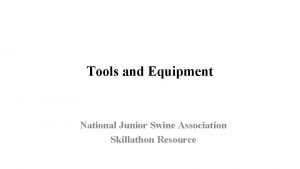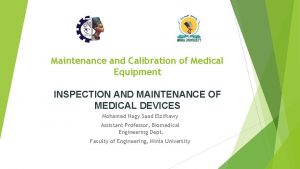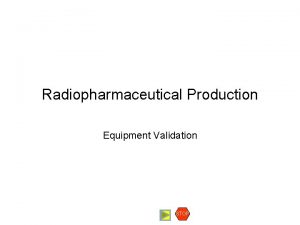Video Production Checklist Video Equipment Checklist Some things













- Slides: 13

Video Production Checklist

Video Equipment Checklist • • • • • • Some things you may need for a video shoot: Video camera (essential) Tripod Extra SD Cards Power supply and adaptors (3 prong to 2 prong) Power strip/surge protector Extension cords Charged batteries Headphones (to monitor audio) Gaffer’s tape (to tape down cords to prevent tripping over them) Microphone(s) and spare batteries Extension cords for external mics (XLR or mini) Converters and plugs for audio and mics Light kit Whiteboard/reflector Equipment cart Take notes release and a pen Flash light Portable monitor (if the camera doesn’t have a large, color display and you want to review the footage on site) Cell phone (turn ringer off, but useful if you need to phone your contact or forget something)

Signal to Noise Ratio

Handheld Microphones

Lavalier Mics The most commonly used self-worn microphones in a broadcast environment would be lavalier (or lapel) microphones, and headset microphones. They are designed to be small, discreet, positioned extremely close to your sound source and plug into a variety of devices such as wireless belt packs, or direct to your camera.

Wired/Wireless • The key word for these microphones is discreet. Wearable mics are the ultimate solution for maximizing your signal to noise ratio • Wireless units, if you decide to pursue this option can be quite expensive and occasionally prone to interference or configuration issues. If you are a solo videographer or a small production team this can add considerable cost your budget.

The Shotgun Microphone

Microphone Pickup Patterns

Dynamic Mic • (also called a moving-coil microphone) is considered the most rugged professional microphone. • This type of mic is a good choice for electronic newsgathering (ENG) work, where a wide variety of difficult conditions are regularly encountered. • In a dynamic microphone sound waves hit a diaphragm attached to a coil of fine wire. The coil is suspended in the magnetic field of a permanent magnet. • When sound waves hit the diaphragm they move the coil of wire within the magnetic field. As a result, a small electrical current is generated that corresponds to the original sound waves. This signal must be amplified thousands of times. • When small size, optimum sensitivity, and the best quality are all prime considerations, another type of mic, the condenser mic, is often preferred.

Condenser/Capacitor Microphones • Condenser mics work on the principle that governs an electric condenser or capacitor. An ultra-thin metal diaphragm is stretched tightly above a piece of flat metal or ceramic. In most condenser mics a power source maintains an electrical charge between the elements. • Sound waves hitting the diaphragm cause fluctuations in an electrical charge, which then must be greatly amplified by a preamplifier (pre-amp) • The pre-amp can be located within the microphone housing or in an outboard electronic pack. Although most pre-amps output an analog signal, some of the newer models immediately convert the output to digital. • Because they require a pre-amp, this means that, unlike the dynamic mics discussed earlier, most condenser mics require a source of power, either from an AC (standard Alternating Current) electrical power supply or from batteries.

DYNAMIC VS CONDENSER • • Dynamic Mic Advantages Condenser Mic Advantages Rugged More Sensitive Lower Cost Better Audio Quality No Power Required Can Be Extremely Small • Dynamic Mic Disadvantages • Condenser Mic Disadvantages • Lower Sensitivity and Power Output • Higher self-noise • Larger and Heavier • More Fragile • Slower Response Time • More Expensive • Not the Best Choice for Maximum Audio Quality • Prone to Weather Problems and RF Interference

On-Camera Microphones

Positives and Negatives POSITIVES • On-camera mics are compact, lightweight, affordable, and feature universal connections such as a standard hot-shoe mount, and 3. 5 mm microphone jack, which makes them compatible with most DSLR cameras and camcorders on the market. NEGATIVES • As these microphones sit on top of your camera, this may not always give you the optimum signal to noise ratio. If your subject is close enough to the camera (roughly two meters or seven feet) or you’re simply recording the ambience of your environment, these microphones are perfect. For anything further away, you may achieve better results by getting your mic closer to your source using one of the following two microphone types.
 Pre production multimedia
Pre production multimedia Swine breeding rods
Swine breeding rods Heavy equipment inspection checklist
Heavy equipment inspection checklist Biomedical equipment maintenance checklist
Biomedical equipment maintenance checklist They say sometimes you win some
They say sometimes you win some Sometimes you win some sometimes you lose some
Sometimes you win some sometimes you lose some Ice cream count or noncount
Ice cream count or noncount Force and motion
Force and motion Some say the world will end in fire some say in ice
Some say the world will end in fire some say in ice Some say the world will end in fire some say in ice
Some say the world will end in fire some say in ice Some trust in chariots and some in horses song
Some trust in chariots and some in horses song Polycom video conferencing setup
Polycom video conferencing setup What is the point of uchendu’s lecture to okonkwo?
What is the point of uchendu’s lecture to okonkwo? Name some things
Name some things

























